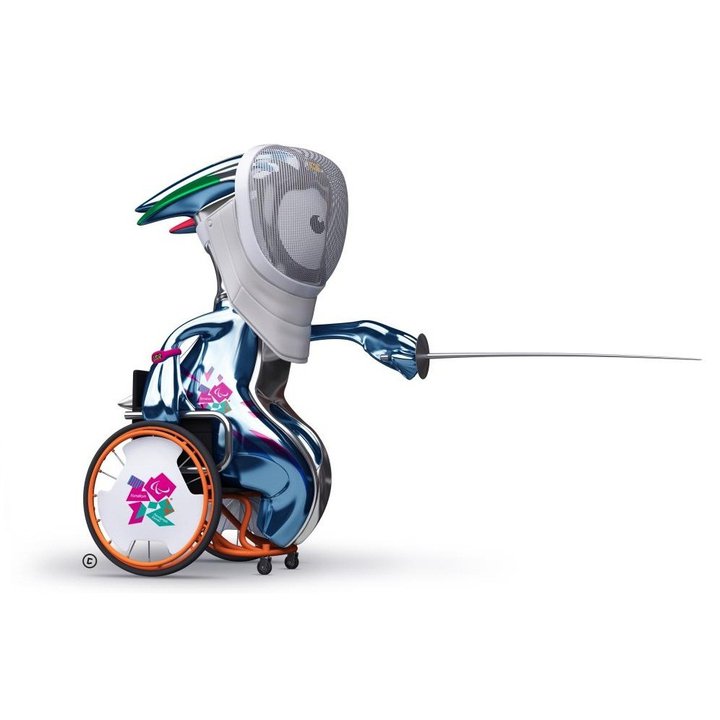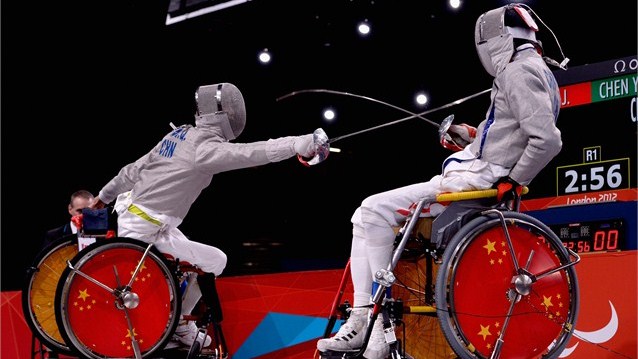
Wheelchair fencing? What do you do, joust?
An all too common question. The sport of Wheelchair Fencing is an official Paralympic sport and was contested at the Rome Paralympics in 1960. At it’s core, wheelchair fencing is a branch of the sport that has been modified to allow participation by individuals who have lost limbs, suffered traumatic brain injuries, have cerebral palsy, or any other medical condition that prevents them from fencing on their feet.
Background:
In 1953 Sir Ludwig Guttmann introduced the sport in England to help wounded war veterans regain strength and coordination. Wheelchair fencing has allowed athletes to remain active.
The United States was introduced to wheel chair fencing in 1994 when a program began at the Shepherd Spinal Center in Atlanta, one of the top rehabilitation hospitals in the nation, specializing in medical treatment, research and rehabilitation for people with spinal cord injury or brain injury.
The United States Fencing Association (“USFA”) is the current national fencing organization that promotes both able-body and Wheelchair fencing. However, training programs and fencing activities are organized by the local member clubs.
The official governing body is the International Wheelchair Fencing Committee (ISMWSF Section). Wheelchair Fencing is an official sport of the Paralympics Games held in the same facilities as the Olympics.In the same facilities. It is comprised of fencers from around the globe.
Wheelchair fencing is open to all athletes who use wheelchairs and also those who would not otherwise be able to balance. There are three divisions of competition, based upon disability.

The Equipment:
The wheelchair is a primary piece of equipment. It is fixed to a metal frame in the performing area to maintain stability. The chair must be fixed at a 110 degree angle to the central bar. The main object is the same as “able-bodied” (“AB”) competition; score a valid touch on your opponent.
(If you are looking to get into wheelchair fencing, check with your insurance carrier to see if the cost of a sports chair may be covered, or if you can pay for it through your insurance Flexible Spending Plan.)
The therapeutic values of fencing, while not scientifically proven, are evident. The sport of fencing has been called “chess at 70 mph.” You have to be able to plot your attack or see what your opponent is doing and block their attack and counter with one of your own in a split second.
“Wheelchair fencing is incredibly fast.” says Darryl Weiss, a lawyer in San Diego, California and a survivor of several strokes and seizures. “I used to AB and due to my health moved to Wheelchair. It is a more a tactical game because you can’t run away; you can only lean back. In my first chair tournament I got set and when the ref gave the command to fence I couldn’t believe how fast I was touched.” I realize that not everybody is going to be able to get out of the chair and walk short distance the way I do. But you are missing one of the greatest support groups n the world and are short changing yourself if you don’t try it”
There are only three training centers in the United States. One such center is the Grand Canyon State Fencing Federation (“GCSFF”.) Pia Douglas, Secretary of the Foundation, started up the GCSFF’s center: “I was wearing other hats at the time that took all my energy and time.” said Douglas. “As Division Chair I always felt there was a category missing and when I had the opportunity to speak about it to a friend who was ready to finance the launch of the program, I thought that it was time to do it.”
“We had a coach and another club offered us a corner of their facility.” Douglas continued. “From there I contacted associations’ and stroke and rehab facilities for people with disabilities. The idea was well received and it gave me the energy to continue. We placed posters and left brochures everywhere and some people began applying. I also contacted the empowerment center in Phoenix and they were very interested in having us in their future gymnasium.
Gary Van der Wege, currently the Head Coach at the San Antonio Fencing Center began chair fencing in 1993 after a motorcycle accident. Since that time he has garnered six national championships in wheelchair fencing, represented the US in Athens at the Paralympics, and at one time ranked 8th in the world in epee. Mr. Van der Wege is also a national level referee.
“In 2000, Les Stawicki (US National Team head coach) noticed my walking limp and approached me about fencing in a wheelchair. I had no idea I was eligible for such, and even believed it would be unfair to other chair fencers for me to come in and ‘dominate’. I soon learned how difficult it would be as I was totally dominated by experienced chair fencers in my first season.
“As a referee, it is a much faster and more furious event to call. Fortunately, I came into it with the perspective of a chair fencer that has helped me see the true intentions of an action. It can be more tiring as the referee must oversee the different bout orders, left and right handed set-ups, managing the setting of distance between the chairs and the potential of somewhat subtle attempts to ‘manipulate’ the distance by the fencer. Safety (security of the chairs in the frames, and the potential of an athlete falling) as well as technical concerns like lame (the metal vest worn by fencers to register a touch) material contacting bare metal on the chair, etc., provide very little time for mental breaks.” “So it’s a good thing the referee does get to sit too.” he added.
“Fencing and the fencing community were a big part of my rehabilitation,” said Van der Wege.
Don’t think you’re going to be a national champion in a year. Some people begin fencing with only the thought of a good workout or as a good conversation starter. For more information on wheelchair fencing, contact Pia Douglas at [email protected] or go to www.wheelchairfencer.org. Join the fun and as the “wheelies “ say “Sit and Fight.”
USFA Wheelchair Fencing Link: usfencing.org/international/wheelchair–fencing







10 Comments
Comments are closed.